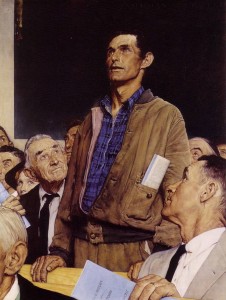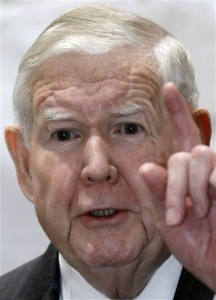There are two things fundamentally wrong with the Obama administration’s efforts to turn the arts into a vehicle for political advocacy. First, it is an egregious abuse of power both in terms of misappropriation of public resources and a chilling of the free expression of ideas at the core of artistic vitality. The second problem is that the resulting art as propaganda usually stinks.

You don’t have to be an ancient history professor to know that government controlled (or heavily influenced) art is, on the whole, lousy. There are still artists alive today who either toiled in or toiled against the socialized artistic regimens of the Soviet Union and Nazi Germany. Some laudable efforts undertaken by the WPA aside, there is no shortage of examples of art and architecture that glorifies the state and crushes the human spirit. The funny thing is that the critics who most abhor the impact on art of the Nazis and Soviets and the works they produced are proud liberals who saw how it helped quash the concepts of non-conformity and innovation that are the life blood of artistic progress.
When Obama’s leftist appointees at the National Endowment for the Humanities came up with the idea that they would recruit fellow-travelers in the arts community to harness their “talent” to promote the One’s political agenda they were hardly charting new territory. Most every regime in history has done the same thing. Allegorical painting is the most common example used by popes and princes to glorify their side of the political story. Chairman Mao’s Red Brigades used drama and opera as tools of the state propaganda machine, and made ruthlessly sure that you didn’t experience any alternative theater on the side.
Shortly after coming to power the National Socialists in Germany established the Reichkulturekammer that recruited artists supportive of the Nazis to commit to producing art that comported to the aesthetic vision of Hitler and his propaganda minister Josef Goebbels who headed up the effort. The resulting art was highly conformist and strictly representational. Sculpture, in particular, managed to capture highly accurate anatomical forms devoid of any sense of human movement or sensuality.

According to Peter Adam in his 1992 book Art of the Third Reich Goebbels made it clear that any artist that did not participate in this program would not be “allowed to be productive in our cultural life.” In a subtler fashion, the NEA controls millions in grant money that is provided to artists on highly subjective terms and is influenced by the political appointees heading the agency. Obama’s appointees can easily reward those who participate in their own kulturekammer and ignore those who choose to produce art that does not promote the administration’s health care proposal or cap and trade legislation.
In the Soviet Union, shortly after the revolution there was short-lived appreciation for the avant-garde seen as anti-bourgeois. But art was still seen as an instrument of the revolution and Proletarian Cultural and Enlightenment Organizations were established to focus the arts toward political ends. Soon, however, Soviet Realism, the staid, strictly representational art favored by Stalin and a more effective propaganda tool was the only style officially allowed. All professional artists were members of unions that set strict rules for style. Any experimentation was done underground and could not be exhibited or sold publicly.
The Soviet regime believed that art was only useful as far as it depicted and furthered the struggle of the proletariat against oppression. As such, Soviet Realism was simplistic in form and greatly limited in scope. While grandiose in scale, (like much of the Nazi art), official art all traced back to the state in that it either glorified the socialist struggle or denigrated that which was considered counter-revolutionary.
For years conservatives and libertarians have been united in their suspicion of the NEA for slightly different reasons. Conservatives did not appreciate the government promoting what they saw as degenerate or incomprehensible art that undermined moral values–motives that were not entirely unlike those of the Germans and Soviets in the 1930’s. The difference being that today’s conservatives didn’t want to see their tax dollars paying for art by which they were offended. Libertarians, on the other hand, simply didn’t see a role for government in art at any level, believing that freedom of expression would allow the public to judge the relative value of artistic expression.
The Obama administration has raised this debate to an entirely new level that unites conservatives and libertarians in their shared revulsion of any attempt to harness the arts to glorify a political agenda. Liberals truly passionate about art should be rallying along with their political opposites, knowing that art controlled by a liberal government will one day inevitably be art controlled by a conservative government and that this is a story that cannot have a happy ending for artistic freedom.
On a more universal, and is some ways more intrinsically important, level, anyone who has suffered through a Michael Moore film or a Harold Pinter play (or studied the art and architecture of the Nazis and Soviets), knows that art for propaganda’s sake is often boring, dehumanizing, and un-entertaining. It is very likely that increased government involvement in the arts will lead us in a direction away from dynamic arts with myriad successes and failures and towards conformity and constriction of expression.
COMMENTS
Please let us know if you're having issues with commenting.